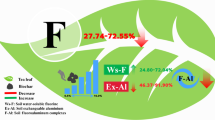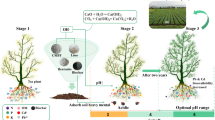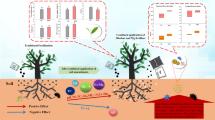Abstract
High levels of fluoride in tea plants pose a potential health risk to humans who drink tea. It has been demonstrated that tea plant fluoride is closely related to the available fluoride in soil. But approaches that could be used to regulate the availability of fluoride in soil have been rarely seen. This study aims to investigate how the addition of charcoal and bamboo charcoal affected soil fluoride availability and bioaccumulation of fluoride in tea plants. In a microcosm experiment, tea plants were grown in the tea garden soil mixed with different amounts of charcoal and bamboo charcoal [that is, 0.5, 1.0, 2.5, and 5.0 % (w/w)]. Soil-fluoride fractions and fluoride accumulated in tea plants were determined using the sequential extraction and ion selective electrode method. Obtained results showed that both charcoal and bamboo charcoal additions significantly enhanced the concentrations of Fe/Mn oxide-bound fluoride, but significantly reduced the concentrations of water-soluble and exchangeable fluoride (p < 0.05) in soil. Charcoal and bamboo charcoal additions also significantly decreased the amounts of fluoride in tea roots and tea leaves (p < 0.05). However, the additions of charcoal and bamboo charcoal had no impacts on the tea quality, as indexed by the concentrations of polysaccharides, polyphenols, amino acids, and caffeine in tea leaves. These results suggested that application of charcoal and bamboo charcoal may provide a useful method to reduce the availability of fluoride in soil and the subsequent fluoride uptake by tea plants.





Similar content being viewed by others
References
Atkinson, C. J., Fitzgerald, J. D., & Hipps, N. A. (2010). Potential mechanisms for achieving agricultural benefits from biochar application to temperate soils: A review. Plant and Soil, 337, 1–18.
Cao, J., Zhao, Y., & Liu, J. (1997). Brick tea consumption as the cause of dental fluorosis among children from Mongol, Kazak and Yugu populations in China. Food Chemistry and Toxicology, 35, 827–833.
Chen, H. M. (2002). Behavior of chemical in soils and environmental quality. Beijing, China: Science Press. (in Chinese).
Chen, H. M. (2005). Environmental soil science. Beijing, China: Science Press. (in Chinese).
Dong, Q. H., Sun, W. J., & Yang, X. Q. (2009). Advances in rhizosphere effect and accumulation mechanism of fluorine intake in Camelllia sinensis. Subtropical Agricultural Research, 5(3):162–166 (in Chinese).
Feng, S. Y., Ms, S. Y., & Yang, H. F. (2006). Maximum cadmium desorption capacities of three sewage irrigating soil types in Beijing. Asian Journal of Ecotoxicology, 1(4), 343–349. (in Chinese).
Fung, K. F., Zhang, Z. Q., Wong, J. W. C., & Wong, M. H. (1999). Fluoride contents in tea and soil from tea plantations and the release of fluoride into tea liquor during infusion. Environmental Pollution, 104, 197–205.
Fung, K. F., Zhang, Z. Q., Wong, J. W. C., & Wong, M. H. (2003). Aluminum and fluoride concentrations of three tea varieties growing at lantau island, Hong Kong. Environmental Geochemistry and Health, 25, 219–232.
Gao, H. J., & Jiang, X. (2010). Effect of initial concentration of hexachlorobenzene on its adsorption–desorption characteristic and desorption hysteresis in soils. Pedosphere, 20(1), 104–110.
Gao, H. J., Liu, T. T., Zhang, X. C., Zhang, Z. Z., & Wan, X. C. (2011). Bioaccumulation and translocation of fluoride from soils to different parts of tea plants in Anhui Province. Environmental Chemistry, 30(8), 1462–1467 (in Chinese).
Gao, H. J., Zhang, X. C., Cai, H. M., Zhang, Z. Z., & Wan, X. C. (2010). Comparison and optimization of total ionic strength adjustment buffer for determination fluoride in water. Environmental Chemistry, 29(4), 759–764. (in Chinese).
Gheju, M., Balcu, I., & Ciopec, M. (2009). Analysis of hexavalent chromium uptake by plants in polluted soils. Ovidius University Annals of Chemistry, 20(1), 127–131.
Guo, Y. L., Lin, C., & Wu, Z. Z. (1991). Preliminary research on the contents of fluoride in tea. Tea in Fujian, 4, 13–16. (in Chinese).
Khan, M. A., Kim, K. W., Wang, M. Z., Lim, B. K., Lee, W. H., & Lee, J. Y. (2008). Nutrition-impregnated charcoal: an environmentally friendly slow release fertilizer. Environmentist, 28, 231–235.
Li, C. H., Wang, H. Y., Shi, H. Q., Wei, Z. Y., & Lu, X. H. (2003). Preliminary study on water soluble fluoride content in soil and the factors affecting it [J]. Journal of Mountain Agriculture and Biology, 22(2), 99–104. (in Chinese).
Liang, J., Shu, T., & Lin, H. (1996). The aluminum complexes in the xylem sap of tea plant. Journal of Chinese Agricultural Society, 34, 695–702. (in Chinese).
Lu, R. K. (1999). Analytical methods for soil and agricultural chemistry. Beijing, China: Science Press. (in Chinese).
Lu, Y., Guo, W. F., & Yang, X. Q. (2004). Fluoride content in tea and its relationship with tea quality. Journal of Agricultural and Food Chemistry, 52, 4472–4476.
Luo, X. P., He, C. L., Li, L. X., & Yang, L. (2006). Study on the fluoride contents in different tea varieties. Tea in Fujian, 4, 10–13. (in Chinese).
Ma, L. F., Shi, Y. Z., Ruan, J. Y., & Han, W. Y. (2002). Fluorine concentrations in teas from China. Agro-environmental Protection, 21, 537–539. (in Chinese).
Nagata, T., Hayatsu, M., & Kosuge, N. (1993). Aluminium kinetics in the tea plant using 27Al and 19F NMR. Phytochemistry, 32, 771–775.
National Standard of the People’s Republic of China (1987). Tea, determination of free amino acid contents. GB/T 8314–87 (in Chinese).
National Standard of the People’s Republic of China (2008). Determination of total polyphenols and catechins content in tea. GB/T 8313–2008 (in Chinese).
Pansu, M., & Gautheyrou, J. (2006). Handbook of soil analysis: Mineralogical, organic and inorganic methods. Berlin, Heidelberg: Springer-Verlag.
Ren, S. X. (2008). Experimental instruction of plant fiber chemistry. Haerbing, China: North East Forestry University Press. (in Chinese).
Ruan, J. Y., Ma, L. F., Shi, Y. Z., & Han, W. Y. (2003). Uptake of fluoride by tea plant (Camellia sinensis L.) and the impact of aluminum. Journal of the Science of Food and Agriculture, 83(13), 1342–1348.
Ruan, J. Y., Ma, L. F., Shi, Y. Z., & Han, W. Y. (2004). The impacts of pH and calcium on the uptake of fluoride by tea plants (Camellia sinensis L.). Annals of Botany, 93, 97–105.
Ruan, J. Y., & Wong, M. H. (2001). Accumulation of fluoride and aluminum related to different varieties of tea plants. Environmental Geochemistry and Health, 23, 53–63.
Ruan, J. Y., Yang, Y. J., & Ma, L. F. (2007). Recent progress in the research on fluoride in tea: Accumulation characteristics by plants and concentration in products with regarding to the impact on human health. Journal of Tea Science, 27(1), 1–7. (in Chinese).
Sha, J. Q., & Zheng, D. X. (1994). Study on the fluorine contents in the fresh leaves of tea plant planted in Fujian Province. Journal of Tea Science, 14, 37–42.
Shao, F. S., Shi, W., & Yang, S. G. (1999). Correlation analysis among the dissolve fluorine, total fluorine and pH value of soil. Chongqin Environmental Science, 21(1), 49–50. (in Chinese).
Shu, W. S., Zhang, Z. Q., Lan, C. Y., & Wong, M. H. (2003). Fluoride and aluminium concentrations of tea plants and tea products from Sichuan Province, PR China. Chemosphere, 52, 1475–1482.
Simpson, A., Shaw, L., & Smith, A. J. (2001). The bioavailability of fluoride from black tea. Journal of Dentistry, 29, 15–21.
Tian, C., Wang, M. D., & Si, Y. B. (2009). Influences of charcoal amendment on adsorption-desorption of isoproturon in soils. Scientia Agricultura Sinica, 42(11), 3956–3963. (in Chinese).
Wan, X. C. (2003). Tea biochemistry. Beijing: China agricultural press. (in Chinese).
Wang, X. P. (1994). Study on the organic acid excreted by tea roots. Journal of Tea Science, 14(1), 17–22. (in Chinese).
Wang, L. M., & Xia, W. S. (2005). Determination of tea polysaccharides improvement of anthrone-sulfuric acid method. Food Science, 26(7), 185–188. (in Chinese).
Wenzel, W. W., & Blum, W. E. H. (1992). Fluorine speciation and mobile in F contaminated soil. Soil Science, 153, 357–364.
Wu, W. H., Xie, Z. M., Xu, J. M., Hong, Z. P., & Liu, C. (2002). Characteristics of forms of fluorine in soils and influential factors. Environmental Science, 23(2), 104–108. (in Chinese).
Xiang, Q. C., & Liu, D. H. (2002). Effects of fluoride on human health and progress of tea plant accumulation of fluoride and its perspective. Tea Communication, 2, 34–37. (in Chinese).
Xu, R., Wang, Y., Zhao, A., Ji, G., & Zhang, H. (2006). Effect of low molecular weight organic acids on adsorption and desorption of fluoride on variable charge soils. Environmental Geochemistry and Health, 28(1–2), 141–146.
Yi, J., & Cao, J. (2008). Tea and fluorosis. Journal of Fluoride Chemistry, 129, 76–81.
Zhang, X. C., Gao, H. J., Zhang, Z. Z., & Wan, X. C. (2011). Comparison of extraction methods and potentiometric determination of fluoride in tea. Journal of Anhui Agricultural University, 38(1), 27–30. (in Chinese).
Acknowledgments
This work was supported by National Natural Science Foundation of China (41071158), Open Fund of State Key Lab of Soil and Sustainable Agriculture, Institute of Soil Science, Chinese Academy of Sciences (0812000037); the Key Project of Chinese Ministry of Education (210097). We are grateful to anonymous reviewers who give his/her invaluable comments and suggestions for improving this manuscript. We would also like to thank Christian Binz for proofreading this article.
Author information
Authors and Affiliations
Corresponding author
Rights and permissions
About this article
Cite this article
Gao, H., Zhang, Z. & Wan, X. Influences of charcoal and bamboo charcoal amendment on soil-fluoride fractions and bioaccumulation of fluoride in tea plants. Environ Geochem Health 34, 551–562 (2012). https://doi.org/10.1007/s10653-012-9459-x
Received:
Accepted:
Published:
Issue Date:
DOI: https://doi.org/10.1007/s10653-012-9459-x




